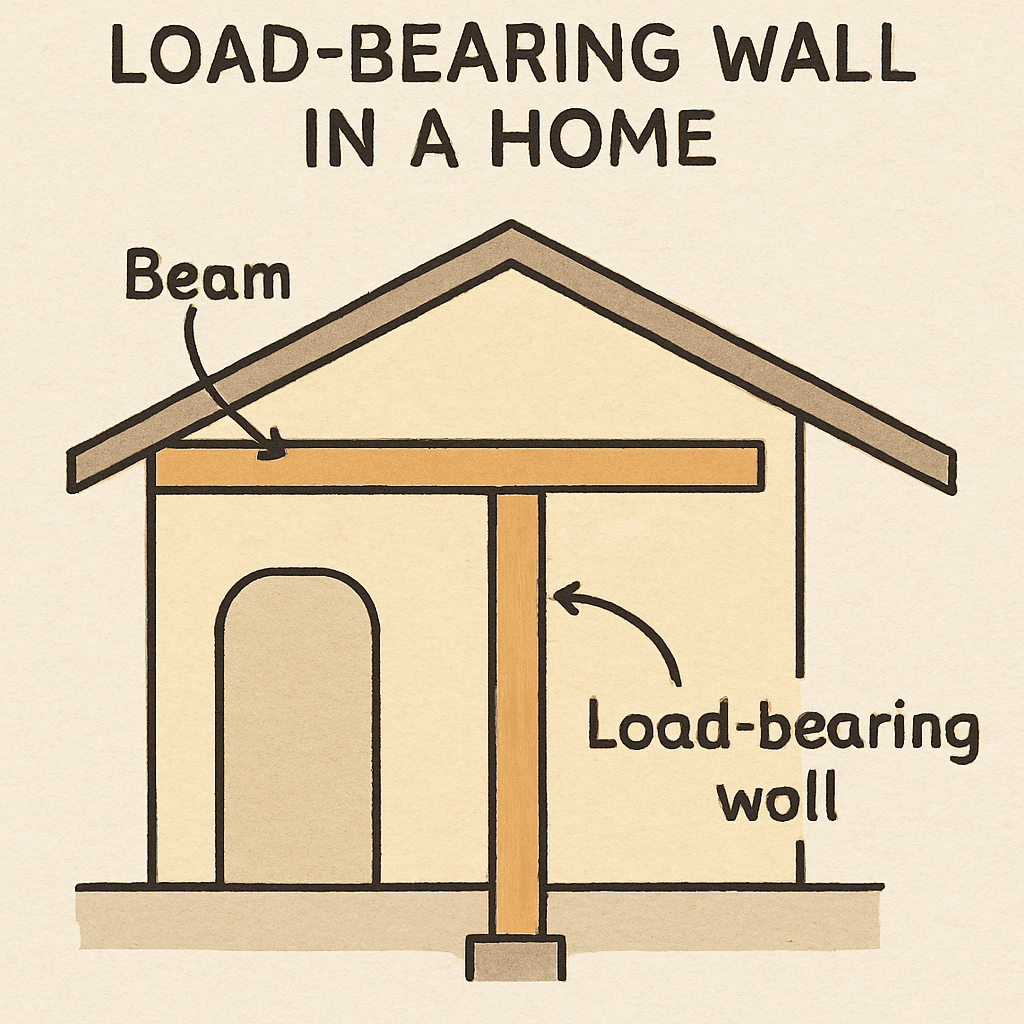Understanding the structure of your home is crucial before any renovation. Load-bearing walls are key components that support the weight of your house. Removing them without proper support can lead to serious structural issues.
Identifying load-bearing walls can be tricky, especially in older homes. These walls often run perpendicular to floor joists and are thicker than non-load-bearing walls.
Before you consider removing a wall, ask yourself, “Is this wall load-bearing or not?” The risks of removing a load-bearing wall without professional guidance are significant.
A structural engineer can help you assess the situation and plan a safe removal. Their expertise ensures your home remains safe and compliant with building codes.
What Is a Load-Bearing Wall? Understanding the Basics
A load-bearing wall is vital for the structural integrity of a building. It supports the weight of the roof, upper floors, and the entire structure above it. Without these walls, the building would lack stability and could collapse.
Such walls are commonly found along the home’s center and exterior. They typically run perpendicular to floor joists. Their removal without appropriate support can lead to severe issues like sagging ceilings or, worse, collapse.
Here are characteristics of load-bearing walls:
- Thicker construction than non-load-bearing walls.
- Located centrally or on the exterior.
- May include structural elements like beams or columns.
Identifying these walls is crucial for any renovation plan. Without proper assessment, removing such walls can lead to costly repairs and compromised safety. Understanding these basics helps ensure informed decisions during home projects.
Why Load-Bearing Walls Matter: The Role in Your Home’s Structure
Load-bearing walls are more than just partitions; they hold up the structure of your entire home. These walls distribute the building’s weight and keep it stable. Without them, your home would lack the necessary support.
Their importance cannot be understated as they anchor key elements in your house. For instance, they support:
- The roof
- Upper floors
- Additional structural features like beams
Removing these walls without proper support can destabilize your home. It might lead to structural failure, causing significant safety hazards. Hence, identifying and preserving these walls is vital. Proper handling of load-bearing walls ensures your home remains safe and structurally sound. Without them, even minor renovations can become risky undertakings.
How to Tell If a Wall Is Load-Bearing: Key Signs to Look For
Identifying load-bearing walls requires careful observation. First, check the building’s blueprints if they are available. Blueprints often highlight structural walls clearly. If not, there are still other reliable ways to identify them.
A common indicator is the position of the wall. Load-bearing walls often run perpendicular to the floor joists above. This alignment suggests the wall supports the weight of the structure above it.
Consider the wall’s thickness. Load-bearing walls are usually thicker than other walls. This extra thickness is necessary to handle the weight they support.
These walls are more likely to be found in the center of the house. Central walls help evenly distribute weight, supporting the roof and upper floors.
Consider the materials used. In older homes, different materials might indicate a load-bearing wall. For instance, brick or concrete is more common in these structural supports.
Visible structural elements can also give clues. Look for:
- Columns or beams integrated with the wall
- Walls that continue from one floor to the next
Some homes have walls that end at the exterior. Such walls are often load-bearing, providing external support.
Lastly, observe any wall that seems essential to the room’s design. Key structural components are usually integrated into these walls. Remember, if in doubt, consult a professional. The assistance of a structural engineer ensures safety and compliance with building regulations.
Special Considerations: Signs of Load-Bearing Walls in Old Homes
Identifying load-bearing walls in old homes can be tricky. These structures might use different materials than modern homes. It’s essential to recognize these differences when assessing a wall’s function.
Older construction methods can obscure load-bearing walls. Historical homes may feature unique building techniques. Examples include:
- Stone or brick support walls
- Thick, solid timber beams
- Steel reinforcements
Additionally, old homes might lack detailed blueprints. This absence means you must rely more heavily on visual clues. Consider the wall’s thickness and any visible structural reinforcements.
In such cases, consult an expert familiar with historical structures. They can provide insight into the building’s original design intentions, ensuring any changes respect its integrity and safety.
What Happens If You Remove a Load-Bearing Wall? Risks and Consequences
Removing a load-bearing wall can lead to serious structural issues. Without proper support, ceilings or floors might start sagging. Eventually, this could result in costly and dangerous repairs.
Another risk is uneven settling, causing cracks in walls or floors. This damage isn’t just cosmetic. It might indicate a significant compromise of your home’s stability.
In the worst-case scenario, parts of your home could collapse. A sudden failure of support could happen without warning. It’s essential to avoid such catastrophic outcomes.
Be aware of these potential issues:
- Sagging ceilings or floors
- Cracked walls
- Uneven floors
- Risk of collapse
Given these risks, never remove a load-bearing wall without professional guidance. Ensuring structural safety should be your top priority. A sound strategy involves consulting with a structural engineer, protecting both your investment and personal safety.
Signs a Load-Bearing Wall Was Removed Improperly
Improper removal of a load-bearing wall often leaves distinct signs. If overlooked, these indicators could lead to more severe issues over time.
Common signs include:
- Sagging or uneven ceilings
- Cracks forming in the walls
- Doors that stick or do not close properly
Additionally, floors may develop unusual slopes or creaks. These changes often occur soon after a wall is mistakenly removed or altered.
It’s critical to address these signs promptly. Consulting a structural engineer can prevent further deterioration. Early intervention saves costs and ensures your home’s continued stability.
Can I Remove This Wall in My House? Why You Need a Structural Engineer
Thinking about removing a wall in your home? The first question you should ask is, “Is this wall load-bearing or not?” Determining this is crucial before taking any action.
A structural engineer is pivotal in this decision-making process. Their expertise can accurately identify load-bearing walls and assess the structural impact of their removal. Relying on them prevents costly mistakes and preserves safety.
Engineers evaluate various factors:
- Wall’s position within your home’s layout
- Type of construction materials used
- Support systems required for proper removal
Attempting DIY removal of load-bearing walls poses significant risks. Without professional guidance, you risk damaging the structural integrity of your home. Involving a structural engineer ensures compliance with building codes and helps maintain the value and safety of your residence.
The Process: How a Structural Engineer Assesses and Plans Wall Removal
Removing a load-bearing wall is a complex task. A structural engineer starts by inspecting the existing structure. They examine blueprints and assess how the wall supports the building.
The engineer evaluates load-bearing capacity and safety concerns. They identify alternative support methods if the wall is removed. Options may include:
- Installing beams or columns
- Reinforcing adjacent walls
- Redistributing weight across the structure
After assessment, they create a detailed plan. This plan highlights necessary modifications and ensures compliance with local building codes. It incorporates safety checks to prevent structural failure. An engineer’s expertise guarantees that the building remains stable, thus avoiding future costly repairs. Their guidance is essential for a successful renovation project.
Open Concept Dreams: Safe Alternatives to Removing Load-Bearing Walls
Dreaming of an open concept space? You don’t always need to remove load-bearing walls. Engineers can offer safe alternatives to achieve your design goals. Such solutions maintain structural integrity while opening spaces.
by Sufyan (https://unsplash.com/@blenderdesigner)
Consider options like:
- Adding open shelving instead of a solid wall
- Replacing the wall with support beams or columns
- Creating wide doorways to connect spaces
These changes enhance your home’s layout without compromising stability. Always prioritize safety and consult professionals before making structural modifications. Smart design choices can transform your home while ensuring it’s safe and sound.
Frequently Asked Questions About Load-Bearing Walls and Wall Removal
When tackling home renovations, many people have questions about load-bearing walls. This section addresses some common inquiries.
Do I need an engineer to remove a wall?
Yes, if the wall is load-bearing, consult a structural engineer. They ensure safe removal and adherence to building codes.
What happens if you remove a load-bearing wall without proper support?
Removing a load-bearing wall without support can lead to structural damage. You risk sagging ceilings, and even collapse.
How can I identify load-bearing walls in my home?
Key signs include thicker walls, those perpendicular to floor joists, and central or exterior placements.
Consider the following:
- Is the wall in the center of the house?
- Does the wall support beams or joists?
- Is it an exterior wall?
Understanding these basics helps make safe renovation choices. Always prioritize structural integrity for the longevity and value of your home.
Key Takeaways: Safety, Value, and Smart Renovation
Recognizing load-bearing wall signs is essential for home renovations. Prioritize safety and consult professionals for successful modifications.
When planning renovations, focus on maintaining structural integrity. Balance design ambitions with practical safety measures.
Important Points to Remember:
- Identify load-bearing walls before any demolition.
- Consult with a structural engineer for guidance.
- Plan wisely to enhance your home’s value safely.
By following these steps, you ensure both safety and enhanced property value. Thoughtful planning can lead to beautiful and secure home transformations. Always remember, expert advice is invaluable for achieving your renovation goals.






